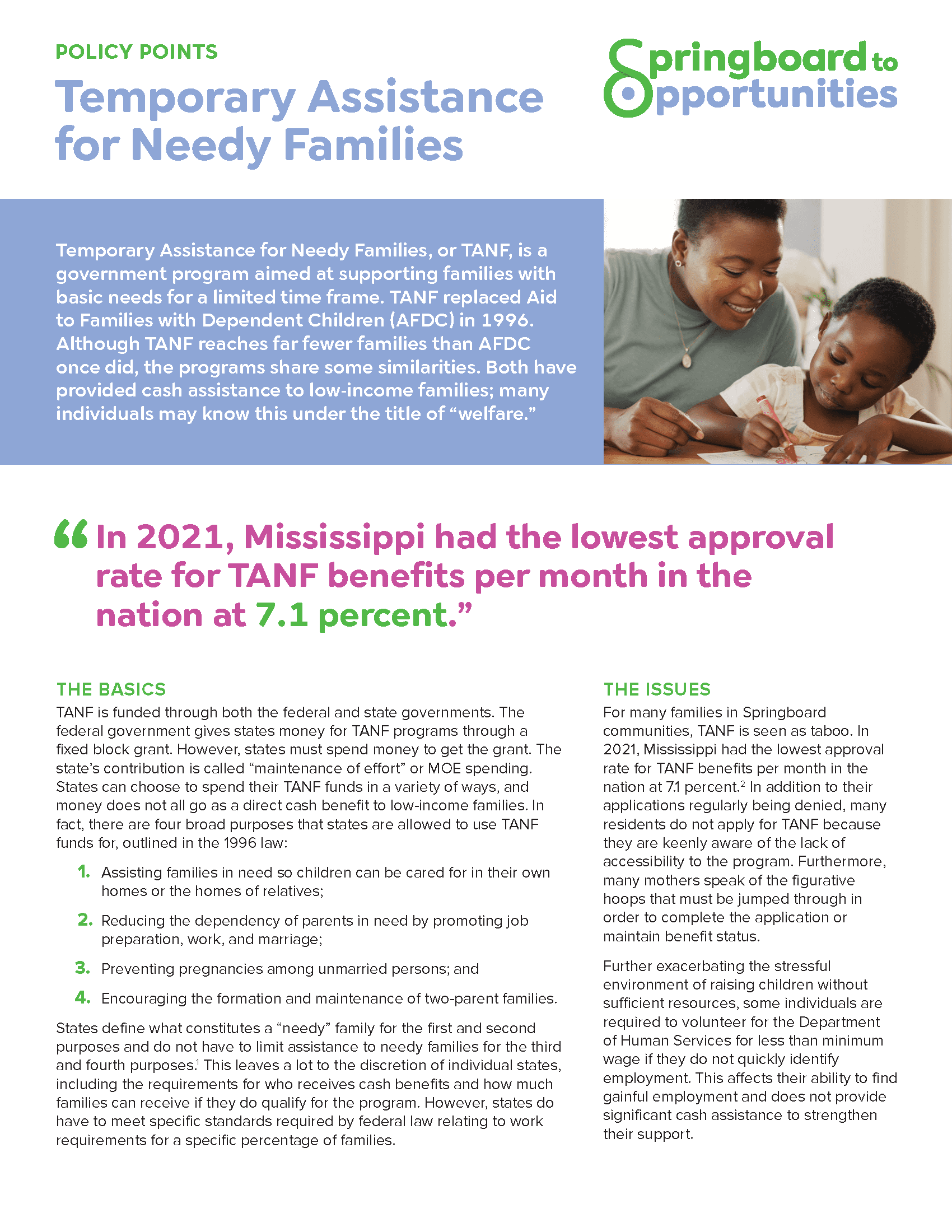POLICY POINTS
Temporary Assistance for Needy Families
Temporary Assistance for Needy Families, or TANF, is a government program aimed at supporting families with basic needs for a limited time frame. TANF replaced Aid to Families with Dependent Children (AFDC) in 1996. Although TANF reaches far fewer families than AFDC once did, the programs share some similarities. Both have provided cash assistance to low-income families; many individuals may know this under the title of “welfare.”
THE BASICS
TANF is funded through both the federal and state governments. The federal government gives states money for TANF programs through a fixed block grant. However, states must spend money to get the grant. The state’s contribution is called “maintenance of effort” or MOE spending. States can choose to spend their TANF funds in a variety of ways, and money does not all go as a direct cash benefit to low-income families. In fact, there are four broad purposes that states are allowed to use TANF funds for, outlined in the 1996 law:
1. Assisting families in need so children can be cared for in their own homes or the homes of relatives;
2. Reducing the dependency of parents in need by promoting job preparation, work, and marriage;
3. Preventing pregnancies among unmarried persons; and
4. Encouraging the formation and maintenance of two-parent families.
States define what constitutes a “needy” family for the first and second purposes and do not have to limit assistance to needy families for the third and fourth purposes.”1 This leaves a lot to the discretion of individual states, including the requirements for who receives cash benefits and how much families can receive if they do qualify for the program. However, states do have to meet specific standards required by federal law relating to work requirements for a specific percentage of families.
1 Policy Basics: Temporary Assistance for Needy Families. (2022, March 1). Center on Budget and Policy Priorities. https://www.cbpp.org/research/family-income-support/temporary-assistance-for-needy-families
THE ISSUES
For many families in Springboard communities, TANF is seen as taboo. In 2021, Mississippi had the lowest approval rate for TANF benefits per month in the nation at 7.1 percent.2 In addition to their applications regularly being denied, many residents do not apply for TANF because they are keenly aware of the lack of accessibility to the program. Furthermore, many mothers speak of the figurative hoops that must be jumped through in order to complete the application or maintain benefit status.
Further exacerbating the stressful environment of raising children without sufficient resources, some individuals are required to volunteer for the Department of Human Services for less than minimum wage if they do not quickly identify employment. This affects their ability to find gainful employment and does not provide significant cash assistance to strengthen their support.
2 Mississippi’s Temporary Assistance for Needy Families (TANF) Program at 25. (2022, October). Mississippi Low-Income Child Care Initiative. https://www.mschildcare.org/wp-content/uploads/2022/10/MS-TANF-at-25_October-2022.pdf

Ashala’s Story
For a mom like Ashala, the paperwork and requirements weren’t worth it for such a small amount of money. She was working in the food service industry and trying to be a full-time caregiver for her grandparents. The only way she could maintain both was to pay for childcare for her daughter, which was $90 per week. The $170 she could receive monthly from Mississippi’s TANF program (recently raised to $260) wasn’t worth it, especially if it could not even cover the cost of childcare.

